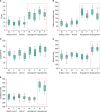Skin Characteristics in Patients with Pityriasis Versicolor Using Non-Invasive Method, MPA5
- PMID: 23197911
- PMCID: PMC3505776
- DOI: 10.5021/ad.2012.24.4.444
Skin Characteristics in Patients with Pityriasis Versicolor Using Non-Invasive Method, MPA5
Abstract
Background: Skin pigmentary changes of pityriasis versicolor may occur as either hyperpigmented or hypopigmented lesions, depending on the outcome of interactions between Malassezia yeasts and the skin, such as lipoperoxidation process, stimulus of inflammatory cell to melanocytes, and increased thickness of keratin layer.
Objective: To investigate skin characteristic factors that enhance the susceptibility to Malassezia yeasts and provoke different color changes of pityriasis versicolor patients.
Methods: To clarify these factors, we investigated the skin characteristics of pityriasis versicolor patients, using a non-invasive method known as MPA 5® (Courage and Khazaka, Germany). A total of 90 normal healthy subjects and 30 pityriasis versicolor patients were included in this study.
Results: Both hyperpigmented and hypopigmented pityriasis versicolor skin lesions showed higher humidity, increased sebum excretion rate and increased transepidermal water loss (TEWL) values than normal healthy subjects. But no significant difference of specific Malassezia yeasts species between hyperpigmented and hypopigmented skin lesions was evident.
Conclusion: These results indicate that higher humidity and increased sebum level provide a better growing environment of Malassezia yeasts in the skin, leading to the assumption that interaction between Malassezia yeasts and skin barrier materials makes disruption of skin barrier causing increased TEWL.
Keywords: MPA 5 (Multiprobe Adapter 5); Malassezia yeasts; Pityriasis versicolor.
Figures




Similar articles
-
Identification and speciation of malassezia in patients clinically suspected of having pityriasis versicolor.Indian J Dermatol. 2013 May;58(3):239. doi: 10.4103/0019-5154.110841. Indian J Dermatol. 2013. PMID: 23723483 Free PMC article.
-
Molecular identification and prevalence of malassezia species in pityriasis versicolor patients from kashan, iran.Jundishapur J Microbiol. 2014 Aug;7(8):e11561. doi: 10.5812/jjm.11561. Epub 2014 Aug 1. Jundishapur J Microbiol. 2014. PMID: 25485051 Free PMC article.
-
Pityriasis versicolor alba.J Eur Acad Dermatol Venereol. 2005 Mar;19(2):147-52. doi: 10.1111/j.1468-3083.2004.01085.x. J Eur Acad Dermatol Venereol. 2005. PMID: 15752280 Review.
-
Study of the distribution of Malassezia species in patients with pityriasis versicolor and healthy individuals in Tehran, Iran.BMC Dermatol. 2004 May 1;4:5. doi: 10.1186/1471-5945-4-5. BMC Dermatol. 2004. PMID: 15119958 Free PMC article.
-
Malassezia yeasts and pityriasis versicolor.Curr Opin Infect Dis. 2006 Apr;19(2):139-47. doi: 10.1097/01.qco.0000216624.21069.61. Curr Opin Infect Dis. 2006. PMID: 16514338 Review.
Cited by
-
Atypical Presentation of Sweat Dermatitis with Review of Literature.Indian Dermatol Online J. 2019 Nov 1;10(6):698-703. doi: 10.4103/idoj.IDOJ_5_19. eCollection 2019 Nov-Dec. Indian Dermatol Online J. 2019. PMID: 31807452 Free PMC article.
-
A case of anti- pityriasis versicolor therapy that preserves healthy mycobiome.BMC Dermatol. 2020 Sep 29;20(1):9. doi: 10.1186/s12895-020-00106-x. BMC Dermatol. 2020. PMID: 32993612 Free PMC article.
-
Speciation of Malassezia and determination of sebum and hydration levels in secondary school students in Nigeria.Arch Dermatol Res. 2024 Dec 2;317(1):63. doi: 10.1007/s00403-024-03575-z. Arch Dermatol Res. 2024. PMID: 39621191
-
Progress in Malassezia Research in Korea.Ann Dermatol. 2015 Dec;27(6):647-57. doi: 10.5021/ad.2015.27.6.647. Epub 2015 Dec 7. Ann Dermatol. 2015. PMID: 26719632 Free PMC article. Review.
References
-
- Adamski Z. Studies of a role played by lipophilic yeasts Malassezia furfur (Pityrosporum ovale, Pityrosporum orbiculare) in different dermatoses. Postepy Dermatol (Poznan) 1995;12:349–454.
-
- Sunenshine PJ, Schwartz RA, Janniger CK. Tinea versicolor. Int J Dermatol. 1998;37:648–655. - PubMed
-
- Morishita N, Sei Y, Sugita T. Molecular analysis of malassezia microflora from patients with pityriasis versicolor. Mycopathologia. 2006;161:61–65. - PubMed
-
- Ahn KJ. Malassezia species cultured from the lesions of pityriasis versicolor. Korean J Dermatol. 1997;35:736–743.
-
- Ahn KJ. Taxonomy of the genus Malassezia. Korean J Med Mycol. 1998;3:81–88.
LinkOut - more resources
Full Text Sources

